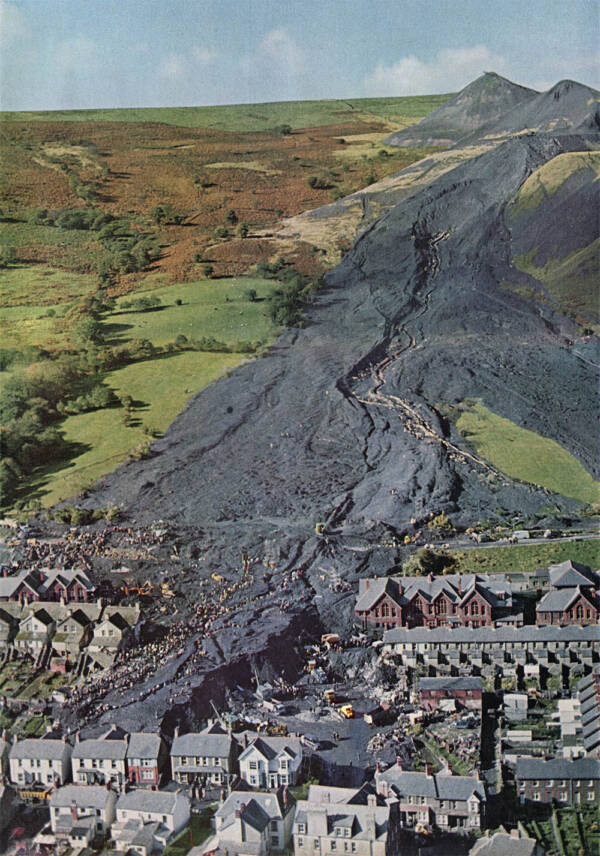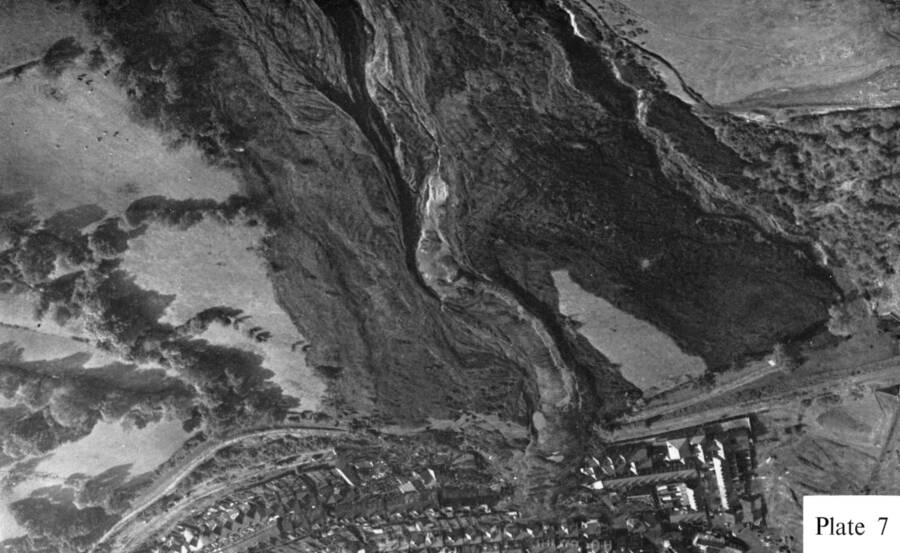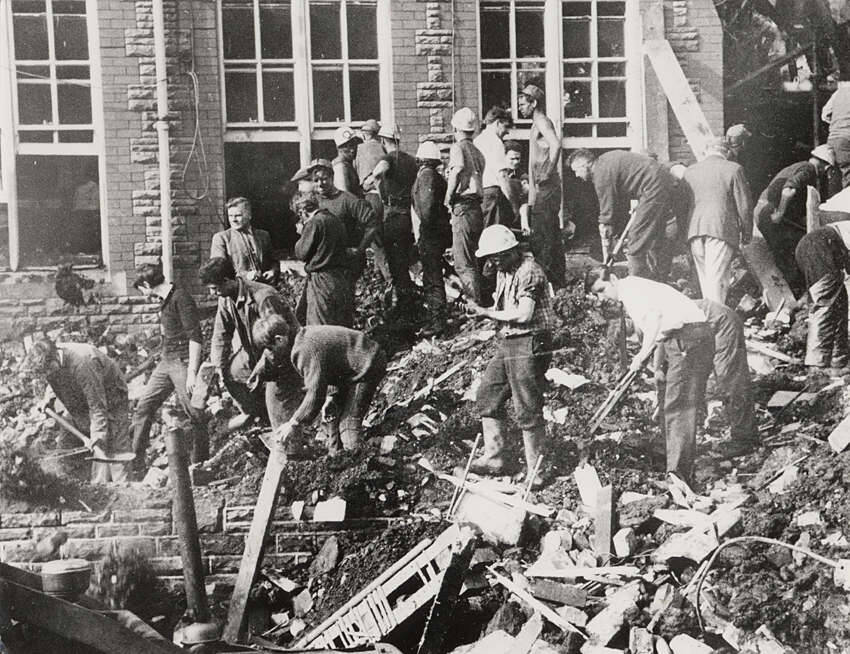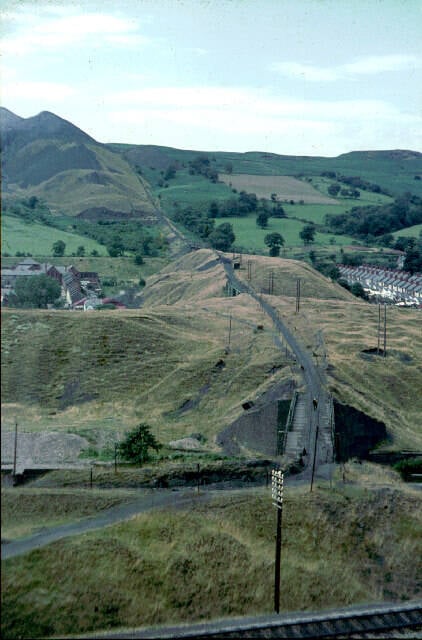A catastrophic collapse of coal waste, the Aberfan disaster engulfed a small Welsh town in 1966, killing 116 children and 28 adults.
In a tiny Welsh mining village called Aberfan, a class of young schoolchildren had just started their math lessons on the morning of October 21, 1966. Then, the students heard a sinister rumble just outside Pantglas Junior School. Seconds later, tons of liquefied coal waste suddenly engulfed their classroom. And thus began the Aberfan disaster.
A young boy named Jeff Edwards was in that classroom when disaster struck. For about an hour and a half, the 8-year-old desperately gasped for air, trapped in the coal waste that completely surrounded him and his classmates. “My desk was pinned against my stomach and a girl’s head was on my left shoulder,” Edwards later remembered. “She was dead.”
Edwards could hear some of his classmates crying. But soon, the room fell silent. He said, “They got quieter and quieter… buried and running out of air.”

HM Stationery OfficeBritain’s worst mining-related disaster destroyed the Welsh village of Aberfan, leaving 144 dead.
Nearly two hours after the landslide struck the classroom, a fireman finally pulled Edwards from the rubble. His blonde hair had apparently stuck out above the debris, saving his life. Edwards was the 10th child pulled from the wreckage of the Aberfan disaster. And he would be the last survivor.
In the end, the Aberfan disaster became infamous as the worst mining-related disaster in British history. Sparked by a period of heavy rain that had liquefied a poorly placed coal tip on a nearby hill, the collapse of coal waste had struck Pantglas Junior School and nearby homes especially hard.
This meant that of the 144 people who died in the disaster, 116 were children. To make matters worse, the tragedy could have been prevented.
How The Aberfan Disaster Unfolded
Prior to the Aberfan disaster, a pile of coal waste sat over 100 feet above the Welsh village. It was one of seven “spoil tips” dug up from a mine nearby. For years, the spoil tips had sat on nearby hills. That is, until heavy rain soaked the 300,000 cubic yards of material in Tip 7, leading to the catastrophe.
Workers at the tip first noticed the coal waste starting to slip down a hillside around 7:30 a.m. on October 21, 1966. The crew attempted to stop the slide. But they couldn’t warn the village below, because the site had no telephone.
“What I saw, I couldn’t believe my eyes,” said eyewitness and crane driver Glyn Brown, according to Northern Mine Research Society. “It rose up… at a tremendous speed. Then it sort of came up out of the depression and turned itself into a wave. That is the only way I can describe it, down towards the mountain, towards Aberfan village, into the mist.”
Leslie Davies, another member of the crew, saw the slide around 9 a.m. “I heard another roar behind me and trees cracking and a tram passing me. I stopped… All I could see was waves of muck, slush, and water.”

HM Stationery OfficeThe landslide caused Tip 7 to collapse, pouring tons of coal waste into Aberfan.
The avalanche of sludge crashed into Aberfan at over 80 miles per hour. Reaching 30 feet high, the “tsunami” of coal waste crushed numerous houses in the village and slammed into Pantglas Junior School.
“I heard a sound which appeared to be like a jet plane screaming low over the school in the fog,” said Kenneth Davies, the acting headmaster at a nearby secondary school in the area. “I saw the houses in Moy Road had vanished in a mass of waste tip material and that the Junior School gable ends or part of the roof, were sticking up out of the morass.”
Soon, locals realized that over 100 children had been caught in the slide.
“Everything was so quiet,” remembered a teacher named Cyril Vaughan, who worked at a nearby school, “as if nature had realized that a tremendous mistake had been made and nature was speechless.”
The Rescue Mission After The Aberfan Disaster
The landslide was only the first stage of the Aberfan disaster. The wall of debris also broke several water pipes, flooding the village, and water poured down the hillside from an underground spring beneath the waste pile.
Teachers quickly leapt into action, carrying vulnerable children across the waters to safety. Before long, other first responders arrived at the scene, and they successfully pulled a 10-year-old boy out of flood waters that had apparently trapped him while he was on his way to school.
“The water was rising and coming up to his head,” one fireman said of the boy’s near-death experience. “We thought he might drown.”

HM Stationery OfficeRecovery efforts focused on Pantglas Junior School, where over 100 children were trapped when disaster struck.
Meanwhile, other firemen, police officers, and volunteers began to dig in the rubble immediately. They saved five students who had been shielded from the landslide by school cook Nansi Williams, who died protecting the children.
After rescuing 8-year-old Jeff Edwards around 11 a.m., volunteers continued to search for potential survivors for hours — and even days after the disaster. According to Smithsonian Magazine, reporter Alix Palmer said the next day, “Men who had started digging at 9:30 the previous morning were still digging, with shirts off and bodies sweating despite the cold.” Sadly, there were no other survivors found after Edwards’ rescue.
It took over two weeks to identify the bodies of the Aberfan disaster victims. In total, 144 people died.
A Disaster That Could Have Been Prevented
Tragically, many had warned of the possibility of a coal waste disaster years earlier. Aberfan’s local council complained to the National Coal Board in the early 1960s, a few years after a nearby mine began piling waste into Tip 7.
“I regard it as extremely serious as the slurry is so fluid and the gradient so steep that it could not possibly stay in position in the winter time or during periods of heavy rain,” an engineer warned in a 1963 letter.
Instead of listening to the warnings, the National Coal Board threatened to close the mine, which would destroy the town’s economy.

Wikimedia CommonsBefore 1966, a tramway carried waste to Tip 7, which collapsed after heavy rain and caused the Aberfan disaster.
After the disaster, a tribunal concluded that the accident “could and should have been prevented.” The tribunal also blamed the National Coal Board for the catastrophe, as it had failed to heed warnings about the coal waste tip.
To make matters worse, some survivors were further traumatized in the aftermath, as they were subjected to agonizing medical tests to determine how much compensation their families would receive after the disaster, according to the BBC. One survivor recalled a visit to a psychiatric hospital, where he was hooked up to machines and was asked if he had nightmares and whether he was afraid of the dark: “I was thinking… ‘You better not say the wrong thing, or you might not be coming back out of here.'”
In the end, as Ceri Jackson of BBC News dubbed it, the deadly Aberfan disaster was a “mistake that cost a village its children.”
The Response Of Queen Elizabeth II
Queen Elizabeth II waited eight days after the Aberfan disaster to visit the village. The royal reportedly worried that her presence would distract from rescue efforts, especially if there were still survivors. But years later, it was said that the queen’s decision to wait was one of her biggest regrets.
At the time, she was 40 years old and had four children, two of whom were young. There was no question that her visit to Aberfan affected her. According to biographer Robert Lacey, Elizabeth’s “gaunt features, etched with grief, were the more moving for being so clearly genuine.”
She briefly abandoned her famous “stiff upper lip” for the people of Aberfan, showing clear emotion at the tragic loss of so many children, a historic scene that would later be dramatized in the Netflix series The Crown.

HM Stationery OfficeAn aerial photograph showcasing the devastation in Aberfan.
Though the queen was criticized for delaying her visit, many in Aberfan appreciated her arrival, including Denise Morgan, who lost her sister in the tragedy. “To me that day, she didn’t come as the Queen, our monarch, she came as a mother, to sympathise, to empathise, to really appreciate what everybody had been through that day,” said Morgan.
The queen went on to visit Aberfan multiple times during her reign. On the 50th anniversary of the disaster, she recalled a child she met in 1966 who gave her a posy with a note: “From the remaining children of Aberfan.”
In the aftermath of the Aberfan disaster, the government cleaned up the remaining piles of coal mine waste and passed new regulations and safety standards to prevent similar catastrophes in the future.
After reading about the Aberfan disaster and the tumultuous aftermath, learn about the New York City smog emergency of 1966 that killed 200 people. Then, read about some more deadly disasters from modern history.





